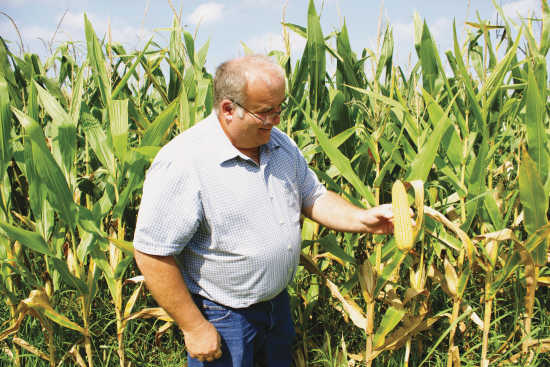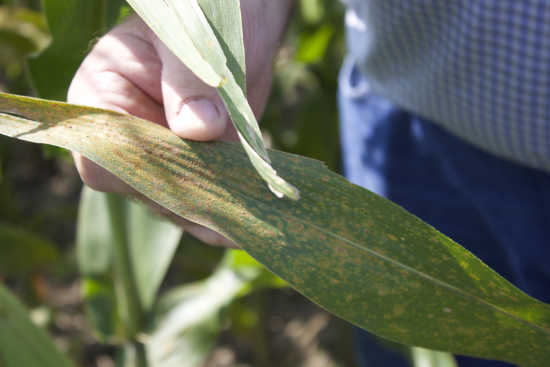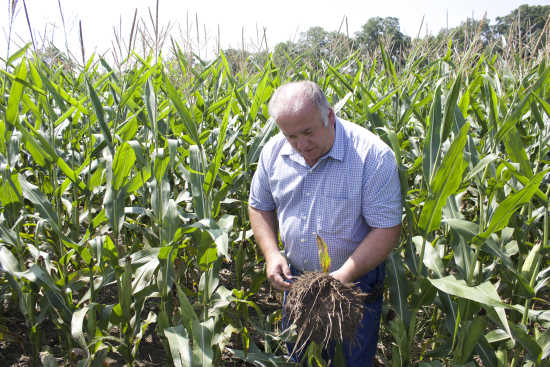Too much rain ruined farmer's late season crops, could effect local economy
While water is necessary for all living and growing things, for Vernon County farmers this growing season, water could provide too much of a good thing.
An average of 5.08 inches of precipitation fell monthly from April through July in Vernon County this year, compared to an average of 4.6 inches of precipitation having fell each of those months across Missouri, reported by USA.com, a local-weather web site. With all of the rain that has fallen in Vernon County, corn crops have not been able to retain nutrients such as nitrogen and have developed diseases and fungi.

"Somebody in Nevada told me the other day, they recorded 21 inches (of rain) in the month of July," Jerry Morris, of Morris Farms in Deerfield said. "So parts of Vernon County saw at least 20 inches of rain last month."
"Corn likes to have its soil dry in its early stages in life -- up until what we call the V5, V6 stages," Morris said.
This year, when Morris planted the cornfields, he said the soil was damp, keeping the young corn from developing deep roots.
"If it is hindered in its young stages of being a plant, then when it gets to its taller stages, -- the reproductive stages -- there's a very high demand for nutrients. If the roots aren't there, they aren't going to get any," Morris said.
Pat Miller, county program director and agronomy specialist at the University of Missouri Extension, said she shared some of the concerns with the amount of water, noting the excess rain led to nitrogen run off from the corn crop.
"Well the corn that went in looks good, but we've had so much rain that the nitrogen that was applied has leeched out into the soil or gone up into the air as gas -- we lose it if it rains too much," Miller said. "A lot of the corn is nitrogen deficient. Although it had enough rain to grow, it didn't have enough nitrogen." Nitrogen is a key element when growing corn, Morris concurred.
Last growing season, Morris said his and other Vernon County farms had overwhelming success growing corn, wheat and soybeans.
"We had near-perfect weather at the start (that year)," Morris said. "This year was just the opposite. If it stays cool, which it did, and it stays wet, then the plant does not get enough heat units (to grow properly). Corn needs a certain amount of those to progress from one growth stage to another. So the more the corn is held back, the more likely it is to run into problems with pollination. Fortunately, the rest of the weather has stayed cool enough that it hasn't been much of an issue. Most of our corn has pollinated pretty well. We've kind of dodged the bullet with pollination."
Morris said he normally plants his crops in the early weeks of April with an expected harvest in the latter weeks of August. In preparation for the rainfall, Morris planted three cycles of corn crop. He made one planting in early April, another later on in April and the final corn planting at the end of June.

Morris said temperature becomes a problem when it is over 85 to 90 degrees. As the corn shuts down to protect itself from heat, it stops growing and performing necessary functions.
This is where more problems start, Morris said. When corn shuts down, not only does it not grow, "But it actually pulls back a little -- just like a human would," he said.
When the farming economy is down, whether it's because of low pricing or low yields or as both, as Morris said, the cash flow stops.
"This (year's harvest) could cause some real desperate times," Morris said. "In many cases farmer's employees will have to be laid-off, they'll have to delay other purchases or forgo them all together. It's a lot like anything else; it's just that Vernon County is a very agrarian economy. We have a tendency to think about 3M and certainly with the loss of American Standard (closed June 2015), a lot of jobs went away. But if you get a really down crop year -- profit year -- it could have the same effect."
Morris said those who got their crops up in time should have good yields, but he was worried about disparity among farmers. He said he expects his farm to have "Anything between 50 bushels to 300 bushels." Normally, Morris Farms sees about 25 bushels to 100 bushels, and while he said 300 bushels probably wouldn't happen, he does expect the corn planted in early April to do better than the corn planted in June.
Morris said the cost of production for a bushel of corn is about $4.
"Right now, you can't get $4 for a bushel," Morris said. "So we're looking at (price) costs below the breakeven point."
Miller said corn was not the biggest crop issue this season. Farmers had difficulty planting soybeans because the soil was drenched. Because soybean plants gave farmers trouble taking to the soggy soil -- Miller said some farmers had to replant the crop three times -- the crop's life cycle was pushed back. As a result the crop was not ready to be harvested in time for farmers to replace the crop's fields with wheat.

"There were thousands of acres in Vernon County where wheat was not planted or was planted weeks after the normal planting period," Morris said.
"One of the other problems farmers saw this year when planting wheat was that the soybeans were not ready to be harvested," Morris said.
The excess precipitation had a negative affect on wheat as well.
"The wheat fields were very muddy at harvest, and so if (farmers) were able to get (wheat) in, they had to do a lot of tillage, which raised a lot of expenses. That delayed the planting or they were unable to do it at all," Morris said.
Miller shared in the discouraged feelings towards the soybeans growth thus far in the season.
"Soybeans, which were planted later this season due to the amount of rain and some farmers had to replant their beans until it took," Miller said. "This time we should have beans (at waist-hight)," she said while miming the crops' desired position. "Last week I drove all around the county and there were two fields with beans (lower than knee-high), not even close to normal. That's really, really late. Whether they make it will depend on when we turn cold in the fall and rain between now and fall.
"Normal planting for soybeans happens sometimes in late April, usually May and early June," Miller said.
"A large percentage of soybean crops got planted in July. That has lots of issues with harvest getting into the fall, freezing weather and even in the snow. That's just a whole other set of issues with how things will play out; it could turn out OK, or it could be a real problem."
